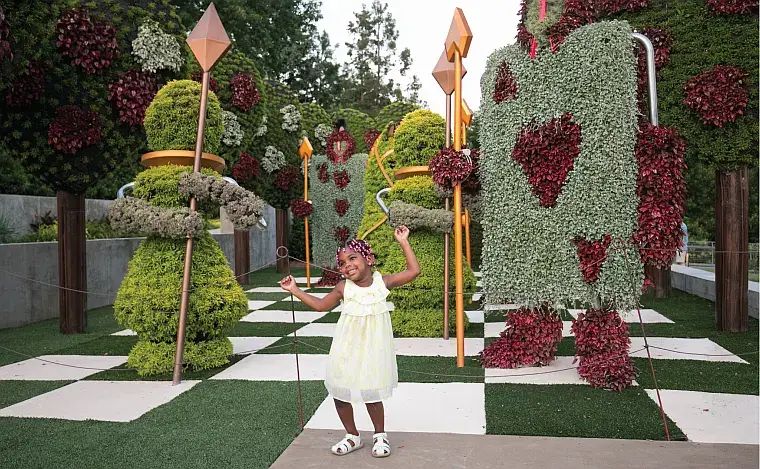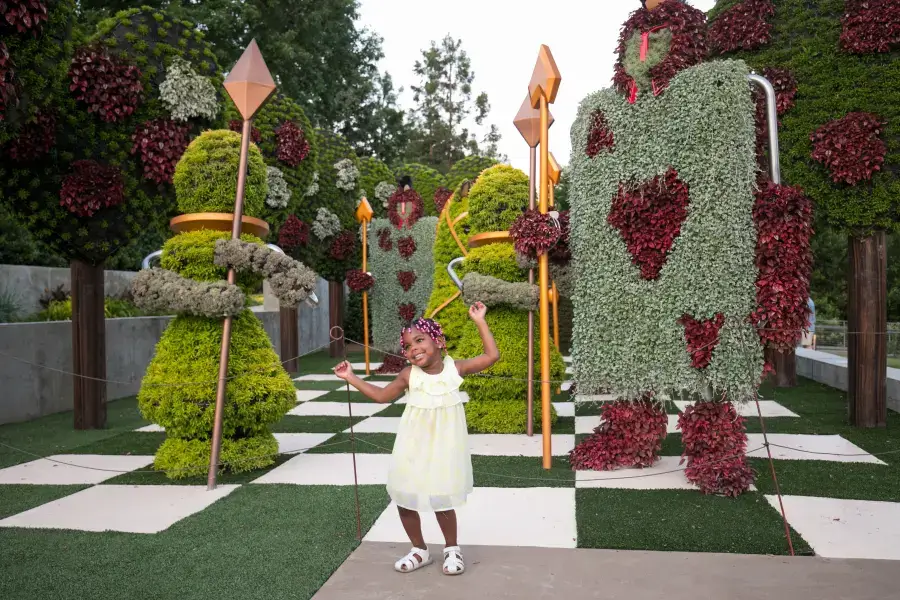Mosaïculture:
A Plant-Based Art Form
By By Jill Maybry, Curator of the Pollinator & Delta Gardens,
Memphis Botanic Garden
Photos courtesy of Atlanta Botanical Garden
Get ready to experience the fantastical world of mosaïculture! Mosaïculture is the horticultural art of creating topiary-like sculptures made up of thousands of annual bedding plants growing on three-dimensional, upright forms. From May 8 through October 31 this year, the Memphis Botanic Garden will host an amazing exhibit of mosaïculture pieces, built in the form of Alice in Wonderland characters, called Alice’s Adventures at the Garden. These incredible pieces range from 3’ to over 20’ tall and get all of their colors from living, growing plants, artfully planted in specific patterns!
“Mosaïculture'' is a strange word made up of the root words “mosaic,” which is the process of making patterns with smaller pieces, and “culture,” which refers to the process of growing things. It combines the art of forming one large showy piece from many smaller, differently-colored pieces with the art and practice of ornamental horticulture.
Each mosaïculture sculpture starts out as a heavy-duty frame constructed of galvanized steel, which gives the piece its shape and support. This metal “skeleton” is wrapped in a special weather-resistant fabric and filled with lightweight potting soil. Tiny, rooted plant cuttings are then inserted through the fabric into the soil, where they begin to expand their roots and produce more foliage and flowers. Different plant species and varieties are carefully arranged in patterns to create the details of each piece. As the plants begin to grow, they are kept fastidiously pruned and trimmed so that they fill in their blocks of color evenly. These living sculptures must continually be pruned, weekly or biweekly depending on the plant’s growth rate, throughout the entire growing season. The giant sculptures are watered by hand every day, all season long. The tiny details of the different pieces dry out faster than the large solid areas, and often must be watered more than once a day. For instance, in this exhibit, the long neck of the Red Queen’s flamingo dries out faster than the solid body of the Queen’s torso and skirt. It takes a dedicated team of horticulture professionals (working seven days a week!) to keep all the sculptures properly watered, trimmed, and looking their best. You’re likely to spot them hard at work on one of the sculptures when you visit.
It may surprise you to learn that the plants making up the bright colors of these living sculptures are the same bedding plants that you can plant in your pots and garden beds at home. The deep red of the roses on the Red Queen’s dress and rose trees comes from red-flowered bronze-leaf wax begonia, a classic and beloved bedding plant. The white roses are made of white-flowered green-leaf begonia. The bright pink flamingo (which the Red Queen is using as a croquet mallet, true to Lewis Carroll’s original book) is made up of pink polka dot plants, a bedding plant grown for its colorful foliage. The red boots and gloves of the playing card guards in The Chess Set are red polka dot plants, and the white trim of Alice’s dress is made of white polka dot plants. The reddish-green stripes of the Cheshire Cat are made of ‘Coral Reef’ sedum, a cold-hardy sedum variety that may be grown as a perennial plant in Memphis gardens. The Cheshire Cat’s pink stripes are a variety of Joseph's coat, called Alternanthera ‘Brazilian Red Hots’. Alternanthera is an annual foliage plant that comes in a wide variety of colors, such as bright yellow, deep burgundy, and vibrant green. It is often used by commercial landscapers to create bright blocks of colors in large landscape designs. It’s a very useful plant for mosaïculture pieces, and you’ll see it used extensively in our Alice exhibit: different Alternanthera varieties have been used for The Red Queen’s dress, Alice’s dress, the rose tree’s leaves in The Chess Set, and even Alice’s bright blonde hair.
One of the most unique, and certainly the “cutest” of the plant combinations, is on the hedgehog, which is serving as The Red Queen’s croquet ball. The hedgehog’s little belly and face are two different Alternanthera varieties, and its fuzzy spines are made from a variety of Carex, a grass-like plant commonly known as leatherleaf sedge. We think you’ll agree that the whole combination is absolutely adorable.
Mosaïculture is a unique blend of art forms: three-dimensional sculpture, combinations of blocks of color, and the art and science of successfully growing living plants. This amazing exhibit is sure to thrill and delight you with its creative use of plants on giant, larger-than-life characters right from the pages of a beloved storybook!
Alice’s Adventures at the Garden was originally designed and developed by the Atlanta Botanical Garden in collaboration with Mosaïcultures Internationales de Montréal. Learn more about Alice’s Adventures at the Garden and plan your visit at membg.org/alice.
Mosaïculture: A Plant-Based Art Form from 4Memphis Magazine







